-
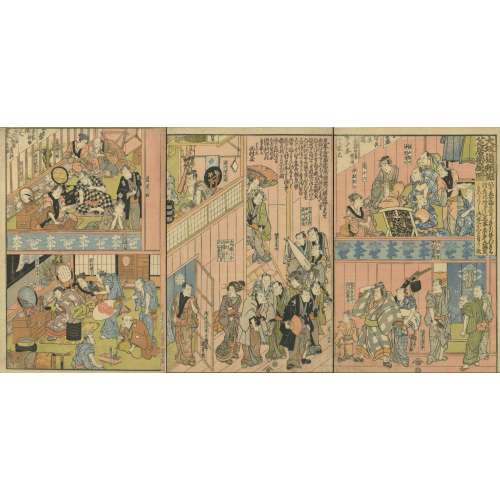 Artist: Utagawa Kunisada [歌川 国貞] a.k.a. Utagawa Toyokuni III [三代歌川豊国] (Japanese, 1786 – 1865). Publisher: Nishimuraya Yohachi [西村屋与八] (Japanese, fl. c. 1751 – 1860), seal name: Eijudō. Date: c. 1821–22 (Bunsei 4–5) Size: Ōban tate-e triptych, each sheet 36.8 x 26.4 cm. Signed: 五渡亭国貞画 – Gototei Kunisada ga (on center sheet). Censor’s seal: kiwame 改印: 極 A view of the dressing room of a Theater in Dōtonbori, Ōsaka (Ōsaka Dōtonbori shibai gakuya no zu): Right sheet: Actors Bandō Mitsuemon I, Asao Tamejūrō III, Ichikawa Danzō V, Nakamura Utaemon III, Bandō Mitsugorō III (in a costume of Matsuômaru), Kiriyama Monji III, Nakamura Utashichi II, Arashi Shôroku IV, Nakamura Matsue III, Matsumoto Kōshirō V, Ichikawa Komazō V. Centre sheet: Arashi Mitsugorō III, Mimasu Daigorō III, Nakayama Bunshichi III, Ichikawa Ichizō II, Bandō Minosuke II, Ichikawa Omezō I, Arashi Kitsusaburō I, Nakamura Utaroku I, Kataoka Nizaemon VII, Ōtani Tomoemon III, Asao Yūjirō I. Left sheet: Asao Kuzaemon I, Arashi Hidenosuke III, Sawamura Gennosuke II, Iwai Ōginosuke, Sawamura Kunitarō II, Iwai Matsunosuke I, Ichikawa Sōzaburō IV, Iwai Hanshirō V (in a costume of Sakuramaru), and Ichikawa Shinzō III (L). The actors are making up for a performance of the “Carriage-Stopping” scene from Sugawara Denju Tenarai Kagami (Sugawara Denju and the Secrets of Calligraphy). References: MFA Accession №: 11.43384a-c; Catalogue Raisonné: Izzard, Kunisada’s World (1993), #34; Hizô Ukiyo-e taikan/Ukiyo-e Masterpieces in European Collections 5, Victoria and Albert Museum II (1987), pl. 22; Keyes, PMA Osaka cat. (1973), #250 and pl. 15 (The theatrical world of Osaka prints, by Roger S. Keyes and Keiko Mizushima, Philadelphia Museum of Art, 1973), pp. 70-71); Izzard, Kunisada's world revisited, 2021; V&A Accession № E.5995-1886. Kabuki actors on this print: Arashi Hidenosuke III [嵐秀之助] (Japanese, fl. 1794 – 1837); other names: Arashi Koshichi IV, Arashi Hinasuke IV, Arashi Sanjūrō VI, Kanō Hidenosuke II, Kanō Umetarō, Arashi Iwajirō III. Arashi Kitsusaburō I [嵐橘三郎] (Japanese, 1769 – 1821); other names: Arashi Kichisaburō II, Arashi Rikan I. Arashi Mitsugorō III (Japanese, ? – ?) Arashi Shōroku IV [四代目嵐小六] (Japanese, 1783 – 1826) Asao Kuzaemon I [浅尾工左衛門] (Japanese, 1758 – 1824); other names: Asai Kuzaemon Nakayama Tashirō II Takeda Nisaburō. Asao Tamejūrō III [三代目淺尾爲十郎] (Japanese, 1780 – 1836); other names: Asao Okuyama III, Asao Okuyama III, Asao Tomozō I. Asao Yūjirō I [浅尾勇次郎] (Japanese, 1782 – 1835); other names: Jitsukawa Gakujūrō I, Asao Gakujūrō, Nakamura Yaozō, Asao Yaozō. Bandō Minosuke II [坂東蓑助] (Japanese, 1802 – 1863); other names: Morita Kan'ya XI, Bandô Mitsugorō IV. Bandō Mitsuemon I [坂東三津右衛門] (Japanese, 1788 – 1846); other names: Bandō Kumahei [坂東熊平]. Bandō Mitsugorō III [三代目 坂東 三津五郎] (Japanese, 1775 – 1831); other names: Bandō Minosuke I, Morita Kanjirô II, Bandō Mitahachi I, Bandō Minosuke I, Bandō Mitahachi I. Ichikawa Danzō V [市川団蔵] (Japanese, 1788 – 1845); other names: Ichikawa Shikō I, Ichikawa Danzaburō IV, Ichikawa Danjirō I, Ichikawa Morinosuke I. Ichikawa Ichizō II [市川市蔵] (Japanese, 1806 – 1829); other names Ichikawa Ebijūrō II, Ichikawa Sukezō I. Ichikawa Komazō V [市川高麗蔵] (Japanese, 1812 – 1849); other names: Matsumoto Kinshō I, Matsumoto Kōshirō VI, Matsumoto Kinshi. Ichikawa Omezō I [市川男女蔵] (Japanese, 1781 – 1833); other names: Ichikawa Benzō II, Ichikawa Bennosuke. Ichikawa Shinzō III [市川新蔵] (Japanese, 1793 – 1837); other names: Ichikawa Sumizō III, Nakayama Tomisaburô II, Nakayama Kinsha, Nakayama Tomisaburō II, Ichikawa Komazō IV, Ichikawa Santarō. Ichikawa Sōzaburō IV (Japanese, ? – ?) Iwai Hanshirō V [岩井半四郎] (Japanese, 1776 – 1847); other names: Iwai Tojaku, Iwai Kumesaburō I. Iwai Matsunosuke I [岩井松之助] (Japanese, 1804 – 1845); other names: Iwai Hanshirō VII, Iwai Shijaku I, Iwai Komurasaki I. Iwai Ōginosuke (Japanese, ? – ?) Kataoka Nizaemon VII [七代目片岡仁左衛門] (Japanese, 1755 – 1837); other names: Yamazawa Kunigorō, Asao Kunigorō II, Nakamura Matsusuke. Kiriyama Monji III [桐山紋治] (Japanese, fl. c. 1803 – 1830); other names: Ichikawa Takigorō. Matsumoto Kōshirō V [五代目松本幸四郎] (Japanese, 1764-1838); other names: Ichikawa Komazô III, Ichikawa Sumizô I. Mimasu Daigorō III [三枡大五郎] (Japanese, 1782 – 1824); other names: Mimasu Seibē, Yoshizawa Kamezō. Nakamura Matsue III [三代目中村松江] (Japanese, 1786-1855); other names: Nakamura Sankō I, Nakamura Tomijūrō II, Ichikawa Kumatarō. Nakamura Utaemon III [中村歌右衛門] (Japanese, 1778 – 1838); other names: Nakamura Tamasuke, Nakamura Baigyoku I, Nakamura Shikan I, Kagaya Fukunosuke I. Nakamura Utaroku I (Japanese, ? – ?) Nakamura Utashichi II (Japanese, ? – ?) Nakayama Bunshichi III [三代目目中山文七] (Japanese, 1764 – 1853); other names: Nakayama Hyakka, Nakayama Hyōtarō I, Nakayama Tokusaburō. Ōtani Tomoemon III [大谷友右衛門] (Japanese, 1793–1839); other names: Arashi Shagan IV, Arashi Sanpachi II, Nakayama Monzaburō. Sawamura Gennosuke II [沢村源之助](Japanese, 1802/7 – 1853); other names: Suketakaya Takasuke III, Sawamura Chōjūrō V, Sawamura Sōjūrō V, Sawamura Tosshō I, Sawamura Genpei I. Sawamura Kunitarō II [沢村国太郎](Japanese, 1798 – 1836); other names: Ogino Kinshi, Ogino Yaegiri III, Ogino Kamekichi, Izumikawa Kamekichi.
Artist: Utagawa Kunisada [歌川 国貞] a.k.a. Utagawa Toyokuni III [三代歌川豊国] (Japanese, 1786 – 1865). Publisher: Nishimuraya Yohachi [西村屋与八] (Japanese, fl. c. 1751 – 1860), seal name: Eijudō. Date: c. 1821–22 (Bunsei 4–5) Size: Ōban tate-e triptych, each sheet 36.8 x 26.4 cm. Signed: 五渡亭国貞画 – Gototei Kunisada ga (on center sheet). Censor’s seal: kiwame 改印: 極 A view of the dressing room of a Theater in Dōtonbori, Ōsaka (Ōsaka Dōtonbori shibai gakuya no zu): Right sheet: Actors Bandō Mitsuemon I, Asao Tamejūrō III, Ichikawa Danzō V, Nakamura Utaemon III, Bandō Mitsugorō III (in a costume of Matsuômaru), Kiriyama Monji III, Nakamura Utashichi II, Arashi Shôroku IV, Nakamura Matsue III, Matsumoto Kōshirō V, Ichikawa Komazō V. Centre sheet: Arashi Mitsugorō III, Mimasu Daigorō III, Nakayama Bunshichi III, Ichikawa Ichizō II, Bandō Minosuke II, Ichikawa Omezō I, Arashi Kitsusaburō I, Nakamura Utaroku I, Kataoka Nizaemon VII, Ōtani Tomoemon III, Asao Yūjirō I. Left sheet: Asao Kuzaemon I, Arashi Hidenosuke III, Sawamura Gennosuke II, Iwai Ōginosuke, Sawamura Kunitarō II, Iwai Matsunosuke I, Ichikawa Sōzaburō IV, Iwai Hanshirō V (in a costume of Sakuramaru), and Ichikawa Shinzō III (L). The actors are making up for a performance of the “Carriage-Stopping” scene from Sugawara Denju Tenarai Kagami (Sugawara Denju and the Secrets of Calligraphy). References: MFA Accession №: 11.43384a-c; Catalogue Raisonné: Izzard, Kunisada’s World (1993), #34; Hizô Ukiyo-e taikan/Ukiyo-e Masterpieces in European Collections 5, Victoria and Albert Museum II (1987), pl. 22; Keyes, PMA Osaka cat. (1973), #250 and pl. 15 (The theatrical world of Osaka prints, by Roger S. Keyes and Keiko Mizushima, Philadelphia Museum of Art, 1973), pp. 70-71); Izzard, Kunisada's world revisited, 2021; V&A Accession № E.5995-1886. Kabuki actors on this print: Arashi Hidenosuke III [嵐秀之助] (Japanese, fl. 1794 – 1837); other names: Arashi Koshichi IV, Arashi Hinasuke IV, Arashi Sanjūrō VI, Kanō Hidenosuke II, Kanō Umetarō, Arashi Iwajirō III. Arashi Kitsusaburō I [嵐橘三郎] (Japanese, 1769 – 1821); other names: Arashi Kichisaburō II, Arashi Rikan I. Arashi Mitsugorō III (Japanese, ? – ?) Arashi Shōroku IV [四代目嵐小六] (Japanese, 1783 – 1826) Asao Kuzaemon I [浅尾工左衛門] (Japanese, 1758 – 1824); other names: Asai Kuzaemon Nakayama Tashirō II Takeda Nisaburō. Asao Tamejūrō III [三代目淺尾爲十郎] (Japanese, 1780 – 1836); other names: Asao Okuyama III, Asao Okuyama III, Asao Tomozō I. Asao Yūjirō I [浅尾勇次郎] (Japanese, 1782 – 1835); other names: Jitsukawa Gakujūrō I, Asao Gakujūrō, Nakamura Yaozō, Asao Yaozō. Bandō Minosuke II [坂東蓑助] (Japanese, 1802 – 1863); other names: Morita Kan'ya XI, Bandô Mitsugorō IV. Bandō Mitsuemon I [坂東三津右衛門] (Japanese, 1788 – 1846); other names: Bandō Kumahei [坂東熊平]. Bandō Mitsugorō III [三代目 坂東 三津五郎] (Japanese, 1775 – 1831); other names: Bandō Minosuke I, Morita Kanjirô II, Bandō Mitahachi I, Bandō Minosuke I, Bandō Mitahachi I. Ichikawa Danzō V [市川団蔵] (Japanese, 1788 – 1845); other names: Ichikawa Shikō I, Ichikawa Danzaburō IV, Ichikawa Danjirō I, Ichikawa Morinosuke I. Ichikawa Ichizō II [市川市蔵] (Japanese, 1806 – 1829); other names Ichikawa Ebijūrō II, Ichikawa Sukezō I. Ichikawa Komazō V [市川高麗蔵] (Japanese, 1812 – 1849); other names: Matsumoto Kinshō I, Matsumoto Kōshirō VI, Matsumoto Kinshi. Ichikawa Omezō I [市川男女蔵] (Japanese, 1781 – 1833); other names: Ichikawa Benzō II, Ichikawa Bennosuke. Ichikawa Shinzō III [市川新蔵] (Japanese, 1793 – 1837); other names: Ichikawa Sumizō III, Nakayama Tomisaburô II, Nakayama Kinsha, Nakayama Tomisaburō II, Ichikawa Komazō IV, Ichikawa Santarō. Ichikawa Sōzaburō IV (Japanese, ? – ?) Iwai Hanshirō V [岩井半四郎] (Japanese, 1776 – 1847); other names: Iwai Tojaku, Iwai Kumesaburō I. Iwai Matsunosuke I [岩井松之助] (Japanese, 1804 – 1845); other names: Iwai Hanshirō VII, Iwai Shijaku I, Iwai Komurasaki I. Iwai Ōginosuke (Japanese, ? – ?) Kataoka Nizaemon VII [七代目片岡仁左衛門] (Japanese, 1755 – 1837); other names: Yamazawa Kunigorō, Asao Kunigorō II, Nakamura Matsusuke. Kiriyama Monji III [桐山紋治] (Japanese, fl. c. 1803 – 1830); other names: Ichikawa Takigorō. Matsumoto Kōshirō V [五代目松本幸四郎] (Japanese, 1764-1838); other names: Ichikawa Komazô III, Ichikawa Sumizô I. Mimasu Daigorō III [三枡大五郎] (Japanese, 1782 – 1824); other names: Mimasu Seibē, Yoshizawa Kamezō. Nakamura Matsue III [三代目中村松江] (Japanese, 1786-1855); other names: Nakamura Sankō I, Nakamura Tomijūrō II, Ichikawa Kumatarō. Nakamura Utaemon III [中村歌右衛門] (Japanese, 1778 – 1838); other names: Nakamura Tamasuke, Nakamura Baigyoku I, Nakamura Shikan I, Kagaya Fukunosuke I. Nakamura Utaroku I (Japanese, ? – ?) Nakamura Utashichi II (Japanese, ? – ?) Nakayama Bunshichi III [三代目目中山文七] (Japanese, 1764 – 1853); other names: Nakayama Hyakka, Nakayama Hyōtarō I, Nakayama Tokusaburō. Ōtani Tomoemon III [大谷友右衛門] (Japanese, 1793–1839); other names: Arashi Shagan IV, Arashi Sanpachi II, Nakayama Monzaburō. Sawamura Gennosuke II [沢村源之助](Japanese, 1802/7 – 1853); other names: Suketakaya Takasuke III, Sawamura Chōjūrō V, Sawamura Sōjūrō V, Sawamura Tosshō I, Sawamura Genpei I. Sawamura Kunitarō II [沢村国太郎](Japanese, 1798 – 1836); other names: Ogino Kinshi, Ogino Yaegiri III, Ogino Kamekichi, Izumikawa Kamekichi. -
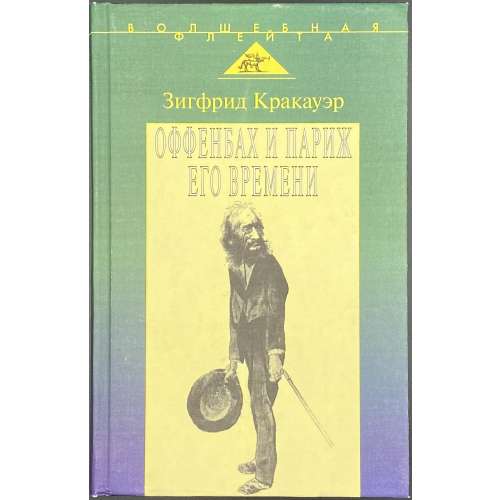 Hardcover, 21.5 x 13.5 cm, pictorial boards, [1-4] 5-412 [2] [2]. Print run 3,000. Translation from German of the original {Siegfried Krakauer. Jacques Offenbach und das Paris seiner Zeit. — Amsterdam: Allert de Lange, 1937} by Serafima Shlapoberskaya – Шлапоберская, Серафима Евгеньевна (Russian, 1921 – 2007).
Hardcover, 21.5 x 13.5 cm, pictorial boards, [1-4] 5-412 [2] [2]. Print run 3,000. Translation from German of the original {Siegfried Krakauer. Jacques Offenbach und das Paris seiner Zeit. — Amsterdam: Allert de Lange, 1937} by Serafima Shlapoberskaya – Шлапоберская, Серафима Евгеньевна (Russian, 1921 – 2007). -
![Конрад Н.И. Театр Кабуки, его история и теория // Японский театр. — Л.-М.: Academia — Всесоюзное Общество культурной связи с заграницей, 1928. — Тир. 3.200 экз. [Сборник статей под редакцией проф. Н. И. Конрада. В книге представлены статьи Н. Конрада, О. Плетнера, Д. Аркина, посвященные традиционному японскому театру. Объём книжки — 60 стр.].](https://varshavskycollection.com/wp-content/uploads/2021/02/LIB-0975.2016-a-scaled-500x500.jpeg) Title page: ВСЕСОЮЗНОЕ ОБЩЕСТВО КУЛЬТУРНОЙ СВЯЗИ С ЗАГРАНИЦЕЙ | ЯПОНСКИЙ ТЕАТР | СБОРНИК СТАТЕЙ | ПОД РЕДАКЦИЕЙ | ПРОФ. Н. И. КОНРАДА | ЛЕНИНГРАД 1928 МОСКВА || T.p. verso: Отпечатано по заказу Всесоюзного | Общества Культурной Связи с загра- | ницей издательством «ACADEMIA» | Государственного Института Истории | Искусств | Обложка работы | Н. А. И А. А. УШИНЫХ | Лениградский Областлит № 12814 […] Тираж 3200 экз. | 2-я типография Транспечати ГКПС, Ленинград, Улица Правды 15. || Bibliographical description: 21.5 x 17 cm; Publisher’s black pictorial wrappers, front cover with lettering: «ЯПОНСКИЙ ТЕАТР» | ВОКС ||, pp. [2] frontis., [2] t.p. / imprint, [2] h.t. / blank, [9] 10-59 [60] – content; collation: [1]7 2-38 46, (first leaf messing from the first gathering), 4 photo illustrations in collation, back black geometrical wrapper. Contents: Н. И. Конрад. Театр в Японии. Общий очерк. — с. 9. Его же. Театр Кабуки, его история и теория. — с. 15. Ол. Плетнер. Театр Кабуки. Социологический очерк. — с. 31. Д. Е. Аркин. Театр Кабуки. Формы и средства театральной выразительности. – c. 45. Personae: Конрад, Николай Иосифович (Russian, 1891 – 1970). Плетнер, Олег Викторович ( Russian, 1893 – 1929). Аркин, Давид Ефимович (Russian, 1899 – 1957). Ушин, Николай Алексеевич (Russian, 1898 – 1942). Ушин , Алексей Алексеевич (Russian, 1904 – 1942).
Title page: ВСЕСОЮЗНОЕ ОБЩЕСТВО КУЛЬТУРНОЙ СВЯЗИ С ЗАГРАНИЦЕЙ | ЯПОНСКИЙ ТЕАТР | СБОРНИК СТАТЕЙ | ПОД РЕДАКЦИЕЙ | ПРОФ. Н. И. КОНРАДА | ЛЕНИНГРАД 1928 МОСКВА || T.p. verso: Отпечатано по заказу Всесоюзного | Общества Культурной Связи с загра- | ницей издательством «ACADEMIA» | Государственного Института Истории | Искусств | Обложка работы | Н. А. И А. А. УШИНЫХ | Лениградский Областлит № 12814 […] Тираж 3200 экз. | 2-я типография Транспечати ГКПС, Ленинград, Улица Правды 15. || Bibliographical description: 21.5 x 17 cm; Publisher’s black pictorial wrappers, front cover with lettering: «ЯПОНСКИЙ ТЕАТР» | ВОКС ||, pp. [2] frontis., [2] t.p. / imprint, [2] h.t. / blank, [9] 10-59 [60] – content; collation: [1]7 2-38 46, (first leaf messing from the first gathering), 4 photo illustrations in collation, back black geometrical wrapper. Contents: Н. И. Конрад. Театр в Японии. Общий очерк. — с. 9. Его же. Театр Кабуки, его история и теория. — с. 15. Ол. Плетнер. Театр Кабуки. Социологический очерк. — с. 31. Д. Е. Аркин. Театр Кабуки. Формы и средства театральной выразительности. – c. 45. Personae: Конрад, Николай Иосифович (Russian, 1891 – 1970). Плетнер, Олег Викторович ( Russian, 1893 – 1929). Аркин, Давид Ефимович (Russian, 1899 – 1957). Ушин, Николай Алексеевич (Russian, 1898 – 1942). Ушин , Алексей Алексеевич (Russian, 1904 – 1942). -
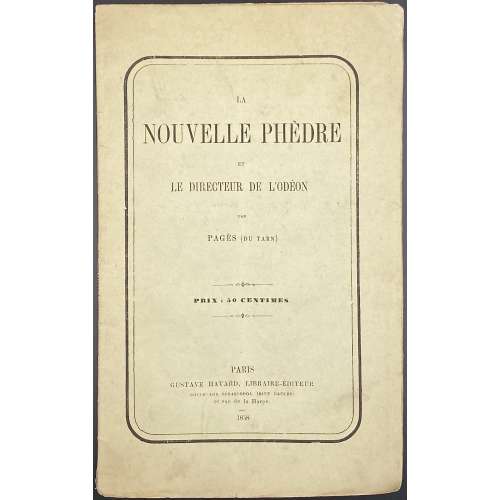 Cover: LA | NOUVELLE PHÈDRE | ET | LE DIRECTEUR DE L'ODEON | PAR | PAGES (DU TARN) | PRIX : 50 CENTIMES | PARIS | GUSTAVE HAVARD, LIBRAIRE–ÉDITEUR | BOULEVARD SÉBASTOPOL (RIVE GAUCHE) et rue de la Harpe. | 1858 || Pagination: [1-3] 4-48. Collation: 8vp; [1]-38 (total 24 leaves) Binding: publisher’s wrappers. Printer: Imprimerie Bonaventure et Ducessois (Paris); Ducessois, Théodore (French, 1804 – after 1864.) Bonaventure, Jules-Frédéric (French, ca. 1816 – 1891) Pagès (du Tarn) (French, fl. 1838 – 1872) – known absolutely nothing. Other works: La France, ode (M. Papailhiau, 1840); Aux Électeurs ... du Tarn (Soupe, 1848) ; Les Funérailles de Napoléon, ode (Pilout, 1840) ; Mazagran, 4, 5 et 6 février 1840, chant héroïque (M. Papailhiau, 1840) ; Herminie, ou l'Amour et l'honneur, tragédie en 5 actes, en vers (Moquet, 1872) ; Lettre à S.E. le ministre de l'Intérieur sur la nouvelle Phèdre et le Théâtre français (Moquet, 1856), etc. There is also a humorous book by Antony de Menou, which does not contain anything of substance: Un contemporain: biographie de Pagès (du Tarn). — Paris: Masgana, 1857. Antony de Menou is an obscure figure in his own right. An article about him can be found at Les derniers bohêmes by Firmin Maillard (1833 – 1901) [LIB-2652.2021].
Cover: LA | NOUVELLE PHÈDRE | ET | LE DIRECTEUR DE L'ODEON | PAR | PAGES (DU TARN) | PRIX : 50 CENTIMES | PARIS | GUSTAVE HAVARD, LIBRAIRE–ÉDITEUR | BOULEVARD SÉBASTOPOL (RIVE GAUCHE) et rue de la Harpe. | 1858 || Pagination: [1-3] 4-48. Collation: 8vp; [1]-38 (total 24 leaves) Binding: publisher’s wrappers. Printer: Imprimerie Bonaventure et Ducessois (Paris); Ducessois, Théodore (French, 1804 – after 1864.) Bonaventure, Jules-Frédéric (French, ca. 1816 – 1891) Pagès (du Tarn) (French, fl. 1838 – 1872) – known absolutely nothing. Other works: La France, ode (M. Papailhiau, 1840); Aux Électeurs ... du Tarn (Soupe, 1848) ; Les Funérailles de Napoléon, ode (Pilout, 1840) ; Mazagran, 4, 5 et 6 février 1840, chant héroïque (M. Papailhiau, 1840) ; Herminie, ou l'Amour et l'honneur, tragédie en 5 actes, en vers (Moquet, 1872) ; Lettre à S.E. le ministre de l'Intérieur sur la nouvelle Phèdre et le Théâtre français (Moquet, 1856), etc. There is also a humorous book by Antony de Menou, which does not contain anything of substance: Un contemporain: biographie de Pagès (du Tarn). — Paris: Masgana, 1857. Antony de Menou is an obscure figure in his own right. An article about him can be found at Les derniers bohêmes by Firmin Maillard (1833 – 1901) [LIB-2652.2021]. -
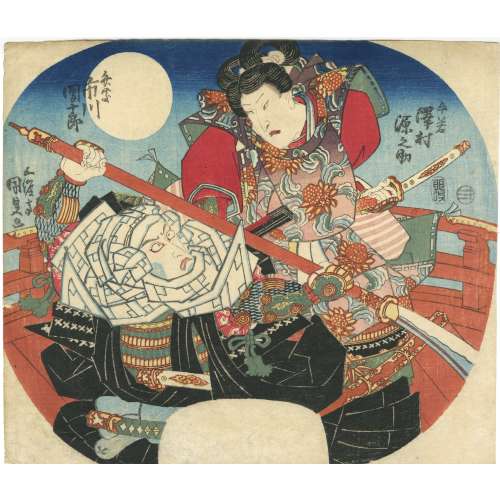 Sawamura Gennosuke II [沢村源之助] (Suketakaya Takasuke III, Sawamura Chōjūrō V, Sawamura Sōjūrō V, Sawamura Tosshō I, Sawamura Genpei I, Japanese, 1802/7 – 1853) as Ushiwakamaru [牛若丸], a.k.a. Minamoto no Yoshitsune [源 義経]. Ichikawa Danjūrō VII [市川団十郎] (Ichikawa Ebizō V, Ichikawa Hakuen II, Ichikawa Shinnosuke I, Japanese, 1791 – 1859) as Benkei, a.k.a. Saitō Musashibō Benkei [西塔武蔵坊弁慶] (Japanese, 1155 – 1189) Performance: Grand finale dance play [大切所作事] (ōgiri shosagoto) at Soga Festival - A Composite Piece of Musashi「曽我祭武蔵摂物 ごさいれいむさしのひきもの)」 (Gosairei Musashi no hikimono), performed at Kawarazakiza (河原崎座) in 05/1831 (See kabuki plays from 1831). Soga Festival (Soga Matsuri) is an annual theatre event in Edo (Tokyo). Scene: The Fight on Gojo Bridge or Benkei on the Bridge [橋弁慶] (Hashi Benkei). The story relates how Benkei, first a monk, then a mountain ascetic, and then a rogue warrior, a man of Herculean strength, was subdued by the young Onzoshi Ushiwaka Maru (Yoshitsune) on Gojo Bridge. Benkei wandered around Kyoto with the intention of relieving 1000 samurai of their swords. One night, with one more sword to go, he saw Yoshitsune playing the flute and wearing a golden sword at the Gojotenjin Shrine. They agreed to fight on Gojo Bridge in southern Kyoto. However, Yoshitsune was too agile for Benkei and had been educated in the secrets of fighting by the tengu. Following Yoshitsune’s victory, Benkei became Yoshitsune’s retainer. Artist: Utagawa Kunisada [歌川 国貞], a.k.a. Toyokuni III (Japanese, 1786 – 1865). Publisher: Ibaya Senzaburo [伊場屋仙三郎]. Signed: Gototei Kunisada ga [五渡亭国貞画]. Date-aratame seal: Tenpō 2 (1831). Size: Fan print (uchiwa-e). Ref.: (1) Tokyo Metropolitan Library, 請求記号 M339-6/東M339-006. (2) Ritsumeikan University, Art Research Center, Portal Database M339-006(02).
Sawamura Gennosuke II [沢村源之助] (Suketakaya Takasuke III, Sawamura Chōjūrō V, Sawamura Sōjūrō V, Sawamura Tosshō I, Sawamura Genpei I, Japanese, 1802/7 – 1853) as Ushiwakamaru [牛若丸], a.k.a. Minamoto no Yoshitsune [源 義経]. Ichikawa Danjūrō VII [市川団十郎] (Ichikawa Ebizō V, Ichikawa Hakuen II, Ichikawa Shinnosuke I, Japanese, 1791 – 1859) as Benkei, a.k.a. Saitō Musashibō Benkei [西塔武蔵坊弁慶] (Japanese, 1155 – 1189) Performance: Grand finale dance play [大切所作事] (ōgiri shosagoto) at Soga Festival - A Composite Piece of Musashi「曽我祭武蔵摂物 ごさいれいむさしのひきもの)」 (Gosairei Musashi no hikimono), performed at Kawarazakiza (河原崎座) in 05/1831 (See kabuki plays from 1831). Soga Festival (Soga Matsuri) is an annual theatre event in Edo (Tokyo). Scene: The Fight on Gojo Bridge or Benkei on the Bridge [橋弁慶] (Hashi Benkei). The story relates how Benkei, first a monk, then a mountain ascetic, and then a rogue warrior, a man of Herculean strength, was subdued by the young Onzoshi Ushiwaka Maru (Yoshitsune) on Gojo Bridge. Benkei wandered around Kyoto with the intention of relieving 1000 samurai of their swords. One night, with one more sword to go, he saw Yoshitsune playing the flute and wearing a golden sword at the Gojotenjin Shrine. They agreed to fight on Gojo Bridge in southern Kyoto. However, Yoshitsune was too agile for Benkei and had been educated in the secrets of fighting by the tengu. Following Yoshitsune’s victory, Benkei became Yoshitsune’s retainer. Artist: Utagawa Kunisada [歌川 国貞], a.k.a. Toyokuni III (Japanese, 1786 – 1865). Publisher: Ibaya Senzaburo [伊場屋仙三郎]. Signed: Gototei Kunisada ga [五渡亭国貞画]. Date-aratame seal: Tenpō 2 (1831). Size: Fan print (uchiwa-e). Ref.: (1) Tokyo Metropolitan Library, 請求記号 M339-6/東M339-006. (2) Ritsumeikan University, Art Research Center, Portal Database M339-006(02).
-
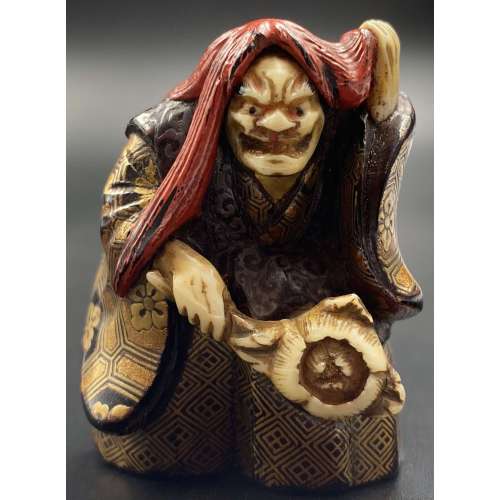 An actor dressed as a witch, with red hair, a gold patterned costume with tortoiseshell and flower lozenge design, and an inlaid ivory mask, hands, feet and flower blossom. Signature to the bottom: Kogyoku [光玉]. Dimensions: 4.17 x 3.07 x 2.99 cm. Provenance: Collection of Gloria and Joe Kurilecz. Sold by Eldred's, on August 25, 1993, Lot #699.
An actor dressed as a witch, with red hair, a gold patterned costume with tortoiseshell and flower lozenge design, and an inlaid ivory mask, hands, feet and flower blossom. Signature to the bottom: Kogyoku [光玉]. Dimensions: 4.17 x 3.07 x 2.99 cm. Provenance: Collection of Gloria and Joe Kurilecz. Sold by Eldred's, on August 25, 1993, Lot #699. -
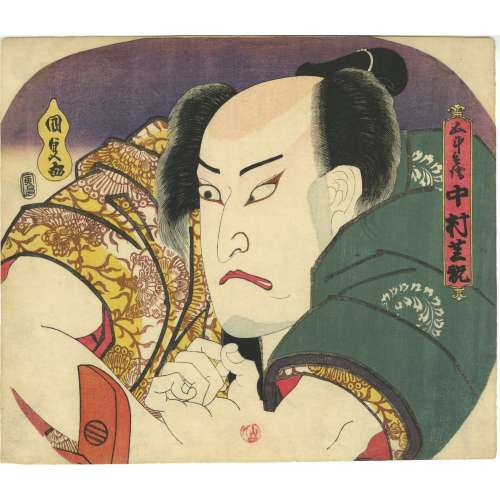 Artist: Utagawa Kunisada [歌川 国貞] a.k.a. Utagawa Toyokuni III [三代歌川豊国] (Japanese, 1786 – 1865). Signed: Kunisada ga [国貞画] in a yellow double-gourd cartouche. Publisher: Ibaya Senzaburo [伊場屋仙三郎] (Japanese, fl. c. 1845 – 1847). Date aratame seal: Bunsei 13 – Tenpō 1 (1830). Actor: Nakamura Utaemon IV [中村歌右衛門] (Japanese, 1796 – 1852); other names: Nakamura Shikan II [二代目中村芝翫], Nakamura Tsurusuke I, Nakamura Tōtarō. Play: Yoshitsune’s Letter at Koshigoe [義経腰越状] (Yoshitsune Koshigoe-jo). Uncut fan print (uchiwa-e, 団 扇 絵), 229 x 267 mm, depicting kabuki actor Nakamura Shikan [中村芝翫] as Gotobei [五斗兵衛]. Nakamura Utaemon IV held the name of Nakamura Shikan II from the 11th lunar month of 1825 to the 1st lunar month of 1836. He was born as Hirano Kichitarō in Edo in 1796. Another fan print with the same subject in this collection [SVJP-0344.2021]:
Artist: Utagawa Kunisada [歌川 国貞] a.k.a. Utagawa Toyokuni III [三代歌川豊国] (Japanese, 1786 – 1865). Signed: Kunisada ga [国貞画] in a yellow double-gourd cartouche. Publisher: Ibaya Senzaburo [伊場屋仙三郎] (Japanese, fl. c. 1845 – 1847). Date aratame seal: Bunsei 13 – Tenpō 1 (1830). Actor: Nakamura Utaemon IV [中村歌右衛門] (Japanese, 1796 – 1852); other names: Nakamura Shikan II [二代目中村芝翫], Nakamura Tsurusuke I, Nakamura Tōtarō. Play: Yoshitsune’s Letter at Koshigoe [義経腰越状] (Yoshitsune Koshigoe-jo). Uncut fan print (uchiwa-e, 団 扇 絵), 229 x 267 mm, depicting kabuki actor Nakamura Shikan [中村芝翫] as Gotobei [五斗兵衛]. Nakamura Utaemon IV held the name of Nakamura Shikan II from the 11th lunar month of 1825 to the 1st lunar month of 1836. He was born as Hirano Kichitarō in Edo in 1796. Another fan print with the same subject in this collection [SVJP-0344.2021]: "...The play Yoshitsune Koshigoe-jo was originally written for the puppet theatre (Bunraku) and staged for the first time in the 7th lunar month of 1754 in Ôsaka at the Toyotakeza. It was a revision of two early plays, Namiki Sōsuke's Nanbantetsu Gotō no Menuki (1735) and Yoshitsune Shin Fukumijō (1744). The title, which suggested that the play focused on Minamoto no Yoshitsune, was in fact dealing with the siege of the Ōsaka Castle, led by Tokugawa Ieyasu to destroy the Toyotomi clan in 1614 and 1615. This play was quickly forbidden because of the 4th act in which Gotobei's wife fired a gun at Yoritomo (this was of course interpreted as an attack on the Shogunate). Yoshitsune Koshigoe-jo was revised in 1770 by Toyotake Ōritsu, who completely rewrote the 4th act for a puppet production at the Kitahorieza in Ōsaka". Yoshitsune Koshigoe-jo was staged for the first time in Edo, at the Ichimuraza on the 9th lunar month of 1790, and is still performed.
Gotobei [五斗兵衛] (Gotohei or Gotobē), one of Yoshitsune’s loyal retainers, is forced to choose between his son’s life or his loyalty to Yoshitsune. Nishikidō brothers, who do not want Gotobei to become Yoshitsune's chief strategist, forced him to drink sake and get asleep. To prove Gotobei's military abilities, Izumi no Saburō fires a gun next to Gotobei's ear, and "he jumps up immediately, in full possession of his senses, ready to repulse any enemy". See: [LIB-1193.2013] Samuel L. Leiter. Kabuki Encyclopedia: An English-language adaptation of Kabuki Jiten. — Westport, CT; London: Greenwood Press, 1979; pp. 266-7).
Ref: [LIB-2993.2022] Fig. 24 in Israel Goldman. Japanese prints and paintings / 40th anniversary; Catalogue 27, 2021.
Two more Kunisada's fan prints (in Paul Griffith's collection), depicting the same actor Nakamura Shikan II as Toneri Matsuōmaru [舎人松王丸] were published in 1832 by Iseya Ichiemon. The play was Sugawara's Secrets of Calligraphy [菅原伝授手習鑑] (Sugawara Denju Tenarai Kagami). See: [LIB-1212.2017] Robert Schaap. Kunisada: Imaging, drama and beauty / Introduction by Sebastian Izzard, contributions by Paul Griffith and Henk. J. Herwig. — Leiden: Hotei Publishing, ©2016.
"...The play Yoshitsune Koshigoe-jo was originally written for the puppet theatre (Bunraku) and staged for the first time in the 7th lunar month of 1754 in Ôsaka at the Toyotakeza. It was a revision of two early plays, Namiki Sōsuke's Nanbantetsu Gotō no Menuki (1735) and Yoshitsune Shin Fukumijō (1744). The title, which suggested that the play focused on Minamoto no Yoshitsune, was in fact dealing with the siege of the Ōsaka Castle, led by Tokugawa Ieyasu to destroy the Toyotomi clan in 1614 and 1615. This play was quickly forbidden because of the 4th act in which Gotobei's wife fired a gun at Yoritomo (this was of course interpreted as an attack on the Shogunate). Yoshitsune Koshigoe-jo was revised in 1770 by Toyotake Ōritsu, who completely rewrote the 4th act for a puppet production at the Kitahorieza in Ōsaka". Yoshitsune Koshigoe-jo was staged for the first time in Edo, at the Ichimuraza on the 9th lunar month of 1790, and is still performed.
Gotobei [五斗兵衛] (Gotohei or Gotobē), one of Yoshitsune’s loyal retainers, is forced to choose between his son’s life or his loyalty to Yoshitsune. Nishikidō brothers, who do not want Gotobei to become Yoshitsune's chief strategist, forced him to drink sake and get asleep. To prove Gotobei's military abilities, Izumi no Saburō fires a gun next to Gotobei's ear, and "he jumps up immediately, in full possession of his senses, ready to repulse any enemy". See: [LIB-1193.2013] Samuel L. Leiter. Kabuki Encyclopedia: An English-language adaptation of Kabuki Jiten. — Westport, CT; London: Greenwood Press, 1979; pp. 266-7).
Ref: [LIB-2993.2022] Fig. 24 in Israel Goldman. Japanese prints and paintings / 40th anniversary; Catalogue 27, 2021.
Two more Kunisada's fan prints (in Paul Griffith's collection), depicting the same actor Nakamura Shikan II as Toneri Matsuōmaru [舎人松王丸] were published in 1832 by Iseya Ichiemon. The play was Sugawara's Secrets of Calligraphy [菅原伝授手習鑑] (Sugawara Denju Tenarai Kagami). See: [LIB-1212.2017] Robert Schaap. Kunisada: Imaging, drama and beauty / Introduction by Sebastian Izzard, contributions by Paul Griffith and Henk. J. Herwig. — Leiden: Hotei Publishing, ©2016.


-
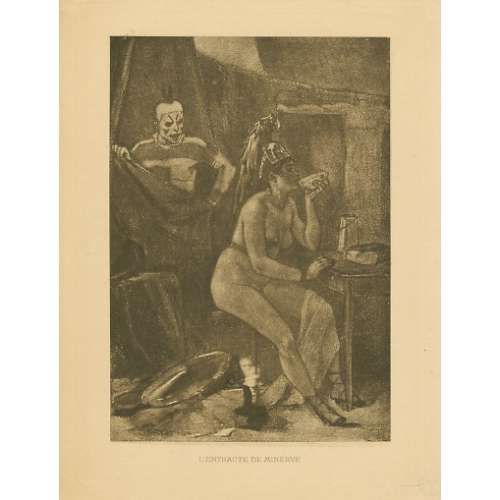
Photogravure after a pastel drawing by F. Rops. Monogrammed in the plate 'FR'. Owner's stamp 'LvM' on verso.
Dimensions: Paper: 26 x 20 cm; Plate: 25 x 18 cm; Image: 21 x 14.5 cm.
Catalogue raisonné: Arthur Hubschmid (1977): 543; Graphics irreverent and erotic (1968): 156.
-
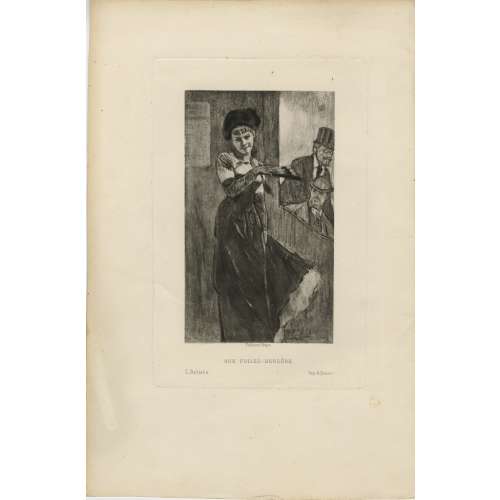
Aquatint finished by a drypoint on wove paper; printed by R. Taneur, depicting young woman in bar Folies Bergère in Paris. Signed in plate under image: "Félicien Rops | AUX FOLIES-BERGÈRE | L'Artiste. — Imp. R. Taneur. Owner's stamp 'LvM' on verso.
Dimensions: Paper: 26.7 x 17.6 cm; Plate: 17.5 x 11.5 cm; Image: 13.5 x 8 cm.
Catalogue raisonné: Graphics irreverent and erotic (1968): 125.
-
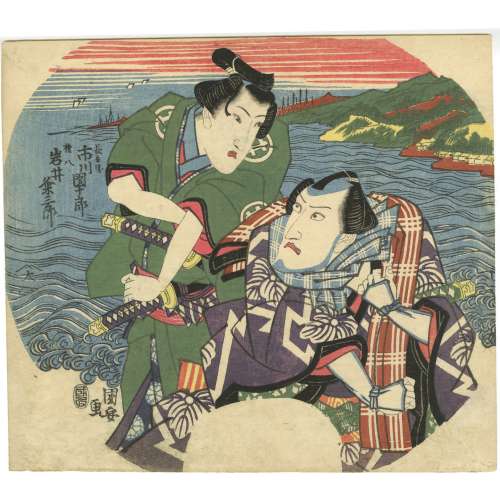 Artist: Utagawa Kuniyasu [歌川 国安] (Japanese, 1794–1832). Publisher seal: [太] (Ta): Marks 02-050 | U421b: An unknown publisher in Edo, fl. c. 1815-61; name assigned according to seal shape “Yama-Ta“. Signed: Kuniyasu ga [国安 画]. Date-aratame seal: Bunsei 9 (1826). Actors: Iwai Hanshirō VI [岩井半四郎] (Japanese, 1799 – 1836), other names: Iwai Hanshirō VI, Iwai Kumesaburō II, Iwai Hisajirō I, Baiga (poetry name), Shūka (poetry name) — as Shirai Gonpachi [白井權八]. Ichikawa Danjūrō VII 市川団十郎 (Japanese, 1791 – 1859), other names: Ichikawa Ebizō V, Ichikawa Hakuen II, Ichikawa Shinnosuke I — as Banzui Chōbei [幡随長兵衛]. Kabuki play: Suzugamori [Suzu-ga-Mori, 鈴ヶ森], a.k.a. Ukiyozuka Hiyoku no Inazuma written by Tsuruya Nanboku IV (Japanese, c. 1755 – 1829). First staged in 1823 at Ichimura-za [市村座] in Edo. Plot: "A gang of evil palanquin bearers are stationed near the Suzugamori execution grounds, where they lay in wait to rob travellers passing through. Gonpachi, who killed a man in his home province, is being sought by the police. He is fleeing to Edo when the bearers attack him in hopes of claiming a reward. He beats them off with great skill. Banzui Chōbei, who is being carried by in a palanquin, sees the attack, admires Gonpachi's ability, and promises to aid him if he is going to Edo". [Samuel L. Leiter. Historical Dictionary of Japanese Traditional Theatre. — Rowman & Littlefield, 2014; p. 382-3.; LIB-2110.2019]. Ref.: Sotheby's.
Artist: Utagawa Kuniyasu [歌川 国安] (Japanese, 1794–1832). Publisher seal: [太] (Ta): Marks 02-050 | U421b: An unknown publisher in Edo, fl. c. 1815-61; name assigned according to seal shape “Yama-Ta“. Signed: Kuniyasu ga [国安 画]. Date-aratame seal: Bunsei 9 (1826). Actors: Iwai Hanshirō VI [岩井半四郎] (Japanese, 1799 – 1836), other names: Iwai Hanshirō VI, Iwai Kumesaburō II, Iwai Hisajirō I, Baiga (poetry name), Shūka (poetry name) — as Shirai Gonpachi [白井權八]. Ichikawa Danjūrō VII 市川団十郎 (Japanese, 1791 – 1859), other names: Ichikawa Ebizō V, Ichikawa Hakuen II, Ichikawa Shinnosuke I — as Banzui Chōbei [幡随長兵衛]. Kabuki play: Suzugamori [Suzu-ga-Mori, 鈴ヶ森], a.k.a. Ukiyozuka Hiyoku no Inazuma written by Tsuruya Nanboku IV (Japanese, c. 1755 – 1829). First staged in 1823 at Ichimura-za [市村座] in Edo. Plot: "A gang of evil palanquin bearers are stationed near the Suzugamori execution grounds, where they lay in wait to rob travellers passing through. Gonpachi, who killed a man in his home province, is being sought by the police. He is fleeing to Edo when the bearers attack him in hopes of claiming a reward. He beats them off with great skill. Banzui Chōbei, who is being carried by in a palanquin, sees the attack, admires Gonpachi's ability, and promises to aid him if he is going to Edo". [Samuel L. Leiter. Historical Dictionary of Japanese Traditional Theatre. — Rowman & Littlefield, 2014; p. 382-3.; LIB-2110.2019]. Ref.: Sotheby's. -
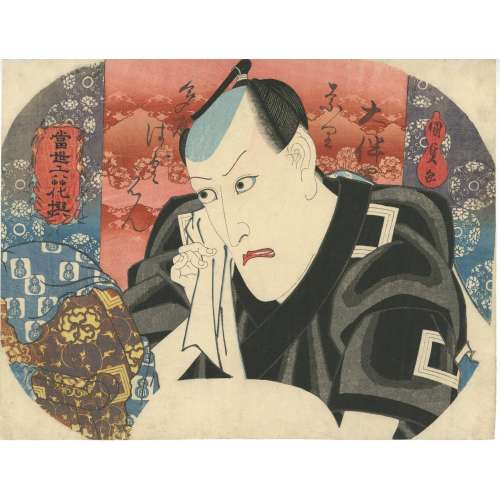 Artist: Utagawa Kunisada [歌川 国貞] a.k.a. Utagawa Toyokuni III [三代歌川豊国] (Japanese, 1786 – 1865). Artists signature: Kunisada ga [国貞画] in a red double-gourd cartouche. Character: Kabuki actor Ichikawa Danjūrō VII [七代目 市川 團十郎]; other names: Ichikawa Ebizō V, Ichikawa Shinnosuke I (Japanese, 1791 – 1859). Series: Six choice modern flowers [當世六花撰] (Tosei rok’kasen). No publisher's seal, no date or censor's seal is present. Size: Fan print (aiban uchiwa-e); 232 x 289 mm. Provenance: Paul F. Walter. Izzard: "... six prints make up this set of fan prints, which compares contemporary artists with classic poets, in this case, Ichikawa Danjūrō VII with Ōtomo no Kuronushi [大友 黒主] (Japanese, dates unknown)". Rok'kasen [六歌仙] – six poetry immortals. According to Izzard, identification of the portrayed person is made possible by mimasu-mon [三升] on the robe, scrolling peony on the back of the mirror, and cloth decorated with the characters Yauan, one of the actor's poetry names, and other signs and symbols, including the inscription of the acter's guild name Naritaya. The absence of the publisher’s emblem and censorship seals may indicate that this was a privately issued print, not for public use. Ref: (1) [LIB-2967.2022] Utagawa Kunisada (1786 – 1865): His world revisited / Catalogue № 17, Exhibition March 17-21, 2021. — NY: Sebastian Izzard, LLC., 2021; p. 130-1, fig. 42). (2) Lyon Collection. Mimasu-mon, or Mitsumasu, is the Ichikawa Danjūrō family crest – three wooden measures, nested square boxes.
Artist: Utagawa Kunisada [歌川 国貞] a.k.a. Utagawa Toyokuni III [三代歌川豊国] (Japanese, 1786 – 1865). Artists signature: Kunisada ga [国貞画] in a red double-gourd cartouche. Character: Kabuki actor Ichikawa Danjūrō VII [七代目 市川 團十郎]; other names: Ichikawa Ebizō V, Ichikawa Shinnosuke I (Japanese, 1791 – 1859). Series: Six choice modern flowers [當世六花撰] (Tosei rok’kasen). No publisher's seal, no date or censor's seal is present. Size: Fan print (aiban uchiwa-e); 232 x 289 mm. Provenance: Paul F. Walter. Izzard: "... six prints make up this set of fan prints, which compares contemporary artists with classic poets, in this case, Ichikawa Danjūrō VII with Ōtomo no Kuronushi [大友 黒主] (Japanese, dates unknown)". Rok'kasen [六歌仙] – six poetry immortals. According to Izzard, identification of the portrayed person is made possible by mimasu-mon [三升] on the robe, scrolling peony on the back of the mirror, and cloth decorated with the characters Yauan, one of the actor's poetry names, and other signs and symbols, including the inscription of the acter's guild name Naritaya. The absence of the publisher’s emblem and censorship seals may indicate that this was a privately issued print, not for public use. Ref: (1) [LIB-2967.2022] Utagawa Kunisada (1786 – 1865): His world revisited / Catalogue № 17, Exhibition March 17-21, 2021. — NY: Sebastian Izzard, LLC., 2021; p. 130-1, fig. 42). (2) Lyon Collection. Mimasu-mon, or Mitsumasu, is the Ichikawa Danjūrō family crest – three wooden measures, nested square boxes.
-
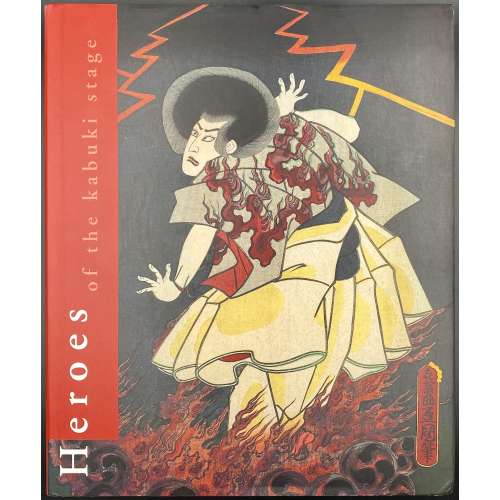 One hardcover volume, 30.2 x 25.3 cm, in red cloth blind stamped to front and spine with lettering, in pictorial dust jacket; pp.: [1-4] 5-359 [360], total 180 leaves, profusely illustrated. Subject: Japan; Theatre; Kabuki theatre; Kabuki actors; Woodblock prints. Contributors: Arendie Herwig (Dutch, fl. 2002 – 2016); Henk Herwig (Dutch, fl. 2002 – 2017).
One hardcover volume, 30.2 x 25.3 cm, in red cloth blind stamped to front and spine with lettering, in pictorial dust jacket; pp.: [1-4] 5-359 [360], total 180 leaves, profusely illustrated. Subject: Japan; Theatre; Kabuki theatre; Kabuki actors; Woodblock prints. Contributors: Arendie Herwig (Dutch, fl. 2002 – 2016); Henk Herwig (Dutch, fl. 2002 – 2017). -
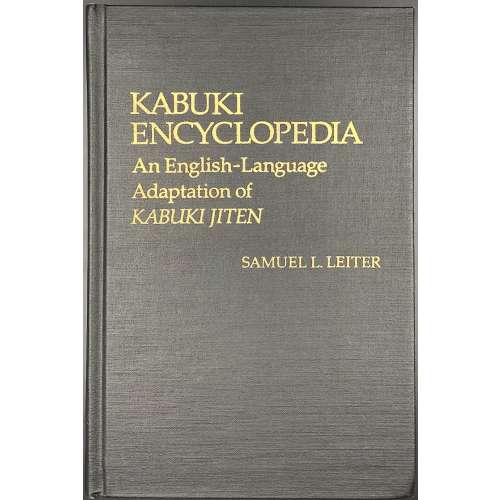 One volume 24.2 x 16.2 x 5.2 cm, in black cloth lettered in gilt to front cover and spine, pp.: i-vii] viii-xxxix [xl blank] [2] 3-572 [2], total 307 leaves, with b/w illustrations. Title-page: KABUKI | ENCYCLOPEDIA | An English-Language | Adaptation of | KABUKI JITEN | SAMUEL L. LEITER | {publisher’s device “GP”} | GREENWOOD PRESS | WESTPORT, CONNECTICUT • LONDON, ENGLAND || Author: Samuel L. Leiter (American, b. 1940)
One volume 24.2 x 16.2 x 5.2 cm, in black cloth lettered in gilt to front cover and spine, pp.: i-vii] viii-xxxix [xl blank] [2] 3-572 [2], total 307 leaves, with b/w illustrations. Title-page: KABUKI | ENCYCLOPEDIA | An English-Language | Adaptation of | KABUKI JITEN | SAMUEL L. LEITER | {publisher’s device “GP”} | GREENWOOD PRESS | WESTPORT, CONNECTICUT • LONDON, ENGLAND || Author: Samuel L. Leiter (American, b. 1940) -
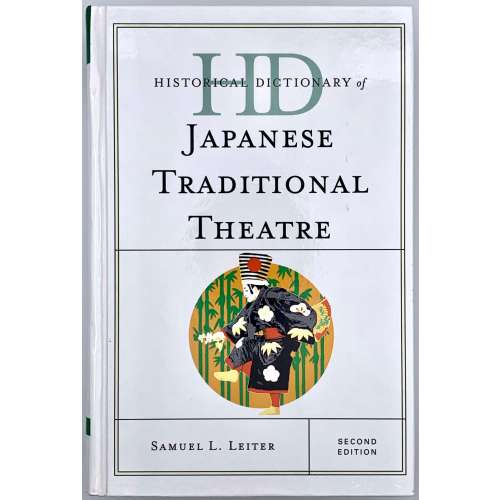 One volume 23.5 x 16 x 6 cm, with glossy pictorial boards lettered to front, back and spine; pp.: [i-viii] ix-xlviii 1-766, total 407 leaves, with b/w illustrations. Title-page: Historical Dictionary of | Japanese Traditional Theatre | Second Edition | Samuel L. Leiter | ROWMAN & LITTLEFIELD | Lanham • Boulder • New York • London || ISBN: 9781442239104. Author: Samuel L. Leiter (American, b. 1940)
One volume 23.5 x 16 x 6 cm, with glossy pictorial boards lettered to front, back and spine; pp.: [i-viii] ix-xlviii 1-766, total 407 leaves, with b/w illustrations. Title-page: Historical Dictionary of | Japanese Traditional Theatre | Second Edition | Samuel L. Leiter | ROWMAN & LITTLEFIELD | Lanham • Boulder • New York • London || ISBN: 9781442239104. Author: Samuel L. Leiter (American, b. 1940) -
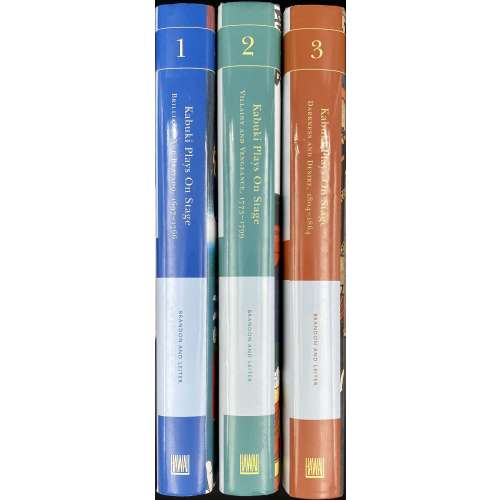 Three volumes, 26.2 x 18.6 cm each: Vol. 1: Kabuki plays on stage: Brilliance and Bravado, 1697-1766; pp.: [i-viii] ix-xiii [xiv blank], 1-391 [1 blank], total 203 leaves, ils. Blue buckram gilt-lettered on spine, pictorial DJ. Vol. 2: Kabuki plays on stage: Villainy and Vengeance, 1773-1799; pp.: [i-viii] ix-xiii [xiv blank], 1-413 [3 blank], total 215 leaves, ils. Green buckram gilt-lettered on spine, pictorial DJ. Vol. 3: Kabuki plays on stage: Darkness and Desire, 1804-1864; pp.: [i-viii] ix-xv [xvi blank], [1] 2-397 [3 blank], total 208 leaves, ils. Ochre buckram gilt-lettered on spine, pictorial DJ. (Vol. 4: Restoration and reform, 1872-1905 – absent for the reason of no interest in the covered period). Contributors: James Rodger Brandon (American, 1927 – 2015) Samuel L. Leiter (American, b. 1940)
Three volumes, 26.2 x 18.6 cm each: Vol. 1: Kabuki plays on stage: Brilliance and Bravado, 1697-1766; pp.: [i-viii] ix-xiii [xiv blank], 1-391 [1 blank], total 203 leaves, ils. Blue buckram gilt-lettered on spine, pictorial DJ. Vol. 2: Kabuki plays on stage: Villainy and Vengeance, 1773-1799; pp.: [i-viii] ix-xiii [xiv blank], 1-413 [3 blank], total 215 leaves, ils. Green buckram gilt-lettered on spine, pictorial DJ. Vol. 3: Kabuki plays on stage: Darkness and Desire, 1804-1864; pp.: [i-viii] ix-xv [xvi blank], [1] 2-397 [3 blank], total 208 leaves, ils. Ochre buckram gilt-lettered on spine, pictorial DJ. (Vol. 4: Restoration and reform, 1872-1905 – absent for the reason of no interest in the covered period). Contributors: James Rodger Brandon (American, 1927 – 2015) Samuel L. Leiter (American, b. 1940) -
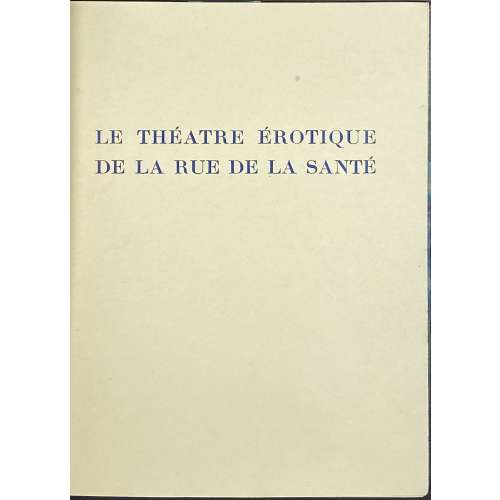 Description: Hardcover, 20.5 x 16 cm, contemporary binding, ¾ calf with raised bands over marbled boards in a marbled slipcase, marbled endpapers, original wrappers preserved, t.e.g., gilt lettering to spine. Content: Scapin Maquereau, drame en un acte par M. Albert Glatigny; La grisette et l’étudiant, pièce en un acte par M. Henry Monnier; Le bout de l’an de la noce, parodie du bout de l’an de l’amour de M. Théodore Barrière par MM. Lemercier de Neuville et J. du Boys; Un caprice par Lemercier de Neuville; Les jeux de l’amour et du bazar, comédie de mœurs en un acte par Lemercier de Neuville. Title-page: LE THÉATRE ÉROTIQUE | DE LA RUE DE LA SANTE | {vignette} | PARIS | — | 1932 || Collation: 2 blanks, original front wrapper with blue lettering «LE THÉATRE ÉROTIQUE | DE LA RUE DE LA SANTE», [1]4 (2 blanks, frontis., h.t. / limitation), [2]4 (t.p., f.t.p., 2 leaves of text), 3-184 (incl. 2 blanks), original back wrapper, original spine, 2 blanks; 5 full-page illustrations within collation, 5 original drawings extraneous to collation. Pagination: [4] [1-8] 9-135 [136] [4], ils. Limitation: 20 copies on Japon and 250 copies on Vélin, this is copy № 12. Edition: 1st edition thus, illustrated with 20 stencil-coloured (au pochoir) photogravures, 5 of them full-page after Feodor Rojankovsky [Rojan], enriched with 5 full-page original crayon drawings by the same artist. Provenance: Stamp with J.-P. Dutel device to 1st blank leaf. Catalogue raisonné: Dutel (1920-1970): 2498, p. 385; Nordmann/Christie’s (2) 515, p. 251 Contributors: Feodor Rojankovsky [Rojan, Фёдор Степанович Рожанковский] (Russian-American, 1891 – 1970) – artist. Joseph Albert Alexandre Glatigny (French, 1839 – 1873) – author. Henry-Bonaventure Monnier (French, 1799 – 1877) – author. Théodore Barrière (French, 1823 – 1877) – author. Louis Lemercier de Neuville [La Haudussière, Louis Lemercier] (French, 1830 – 1918) – author. Jean Charles Duboys [Du Boys] (French, 1836 – 1873) – author. Original crayon drawings by Rojan:
Description: Hardcover, 20.5 x 16 cm, contemporary binding, ¾ calf with raised bands over marbled boards in a marbled slipcase, marbled endpapers, original wrappers preserved, t.e.g., gilt lettering to spine. Content: Scapin Maquereau, drame en un acte par M. Albert Glatigny; La grisette et l’étudiant, pièce en un acte par M. Henry Monnier; Le bout de l’an de la noce, parodie du bout de l’an de l’amour de M. Théodore Barrière par MM. Lemercier de Neuville et J. du Boys; Un caprice par Lemercier de Neuville; Les jeux de l’amour et du bazar, comédie de mœurs en un acte par Lemercier de Neuville. Title-page: LE THÉATRE ÉROTIQUE | DE LA RUE DE LA SANTE | {vignette} | PARIS | — | 1932 || Collation: 2 blanks, original front wrapper with blue lettering «LE THÉATRE ÉROTIQUE | DE LA RUE DE LA SANTE», [1]4 (2 blanks, frontis., h.t. / limitation), [2]4 (t.p., f.t.p., 2 leaves of text), 3-184 (incl. 2 blanks), original back wrapper, original spine, 2 blanks; 5 full-page illustrations within collation, 5 original drawings extraneous to collation. Pagination: [4] [1-8] 9-135 [136] [4], ils. Limitation: 20 copies on Japon and 250 copies on Vélin, this is copy № 12. Edition: 1st edition thus, illustrated with 20 stencil-coloured (au pochoir) photogravures, 5 of them full-page after Feodor Rojankovsky [Rojan], enriched with 5 full-page original crayon drawings by the same artist. Provenance: Stamp with J.-P. Dutel device to 1st blank leaf. Catalogue raisonné: Dutel (1920-1970): 2498, p. 385; Nordmann/Christie’s (2) 515, p. 251 Contributors: Feodor Rojankovsky [Rojan, Фёдор Степанович Рожанковский] (Russian-American, 1891 – 1970) – artist. Joseph Albert Alexandre Glatigny (French, 1839 – 1873) – author. Henry-Bonaventure Monnier (French, 1799 – 1877) – author. Théodore Barrière (French, 1823 – 1877) – author. Louis Lemercier de Neuville [La Haudussière, Louis Lemercier] (French, 1830 – 1918) – author. Jean Charles Duboys [Du Boys] (French, 1836 – 1873) – author. Original crayon drawings by Rojan:
Colour prints after Rojan's drawings: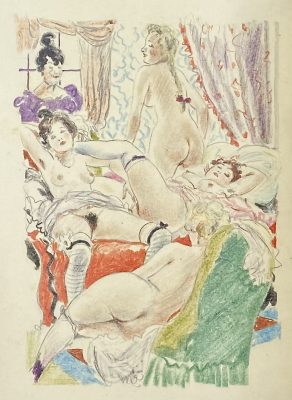
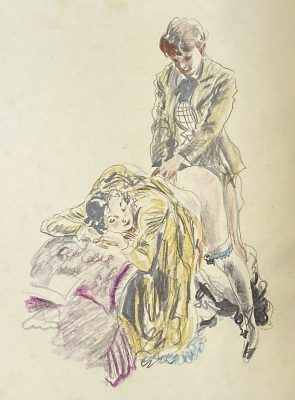
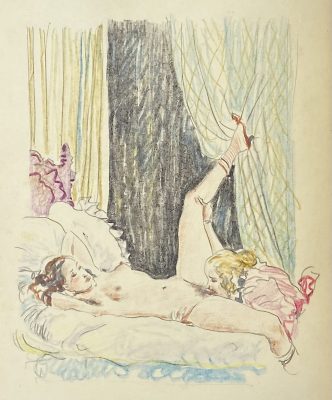
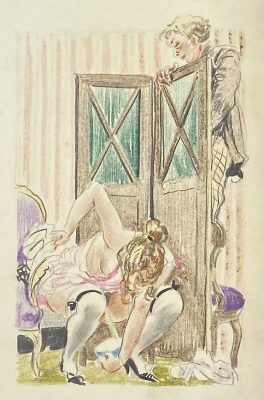
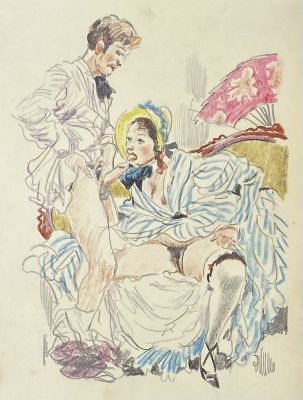
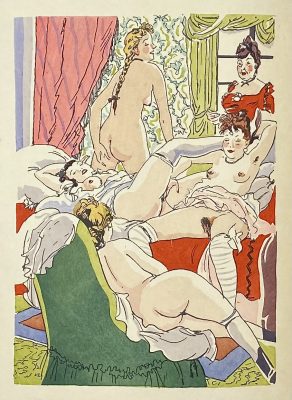
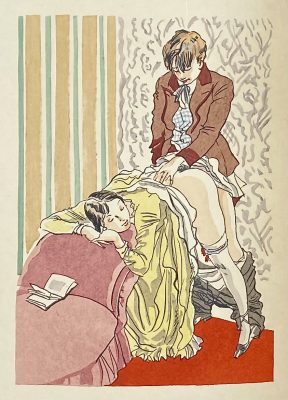
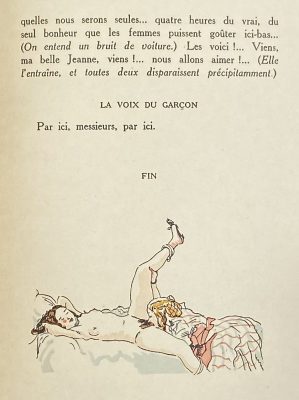
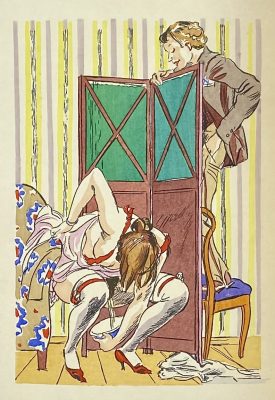
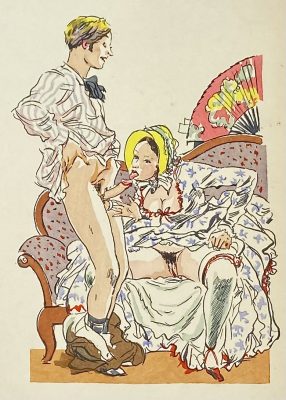
-
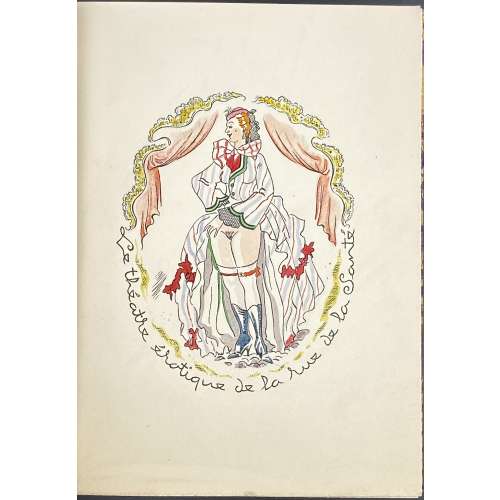 Description: Hardcover small 4to, 20.3 x 15.8 cm, contemporary binding, quarter carrot morocco with raised bands over marbled boards, marbled endpapers, original wrappers preserved, gilt lettering to spine. Content: Scapin Maquereau, drame en un acte par M. Albert Glatigny; La grisette et l’étudiant, pièce en un acte par M. Henry Monnier; Le bout de l’an de la noce, parodie du bout de l’an de l’amour de M. Théodore Barrière par MM. Lemercier de Neuville et J. du Boys; Un caprice par Lemercier de Neuville; Les jeux de l’amour et du bazar, comédie de mœurs en un acte par Lemercier de Neuville. Title-page: LE THÉATRE ÉROTIQUE | DE LA RUE DE LA SANTE | {vignette} | PARIS | — | 1932 || Collation: 3 blanks, original front wrapper with black lettering «LE THÉATRE ÉROTIQUE | DE LA RUE DE LA SANTE», [1]4 (2 blanks, frontis., h.t. / limitation), [2]4 (t.p., f.t.p., 2 leaves of text), 3-184 (incl. 2 blanks), original back wrapper, original spine, 3 blanks; 5 full-page illustrations within collation, 3 original watercolours extraneous to collation bound in between 11 and 12 blank leaves. Pagination: [4] [1-8] 9-135 [136] [4], ils. Limitation: 20 copies on Japon and 250 copies on Vélin, this is copy № 201. Edition: 1st edition thus, illustrated with 20 coloured photogravures, 5 of them full-page after Feodor Rojankovsky [Rojan], enriched with 3 full-page original watercolours by him. Catalogue raisonné: Dutel (1920-1970): 2498, p. 385; Nordmann/Christie’s (2) 515, p. 251 Contributors: Feodor Rojankovsky [Rojan, Фёдор Степанович Рожанковский] (Russian-American, 1891 – 1970) – artist. Joseph Albert Alexandre Glatigny (French, 1839 – 1873) – author. Henry-Bonaventure Monnier (French, 1799 – 1877) – author. Théodore Barrière (French, 1823 – 1877) – author. Louis Lemercier de Neuville [La Haudussière, Louis Lemercier] (French, 1830 – 1918) – author. Jean Charles Duboys [Du Boys] (French, 1836 – 1873) – author. Original watercolours:
Description: Hardcover small 4to, 20.3 x 15.8 cm, contemporary binding, quarter carrot morocco with raised bands over marbled boards, marbled endpapers, original wrappers preserved, gilt lettering to spine. Content: Scapin Maquereau, drame en un acte par M. Albert Glatigny; La grisette et l’étudiant, pièce en un acte par M. Henry Monnier; Le bout de l’an de la noce, parodie du bout de l’an de l’amour de M. Théodore Barrière par MM. Lemercier de Neuville et J. du Boys; Un caprice par Lemercier de Neuville; Les jeux de l’amour et du bazar, comédie de mœurs en un acte par Lemercier de Neuville. Title-page: LE THÉATRE ÉROTIQUE | DE LA RUE DE LA SANTE | {vignette} | PARIS | — | 1932 || Collation: 3 blanks, original front wrapper with black lettering «LE THÉATRE ÉROTIQUE | DE LA RUE DE LA SANTE», [1]4 (2 blanks, frontis., h.t. / limitation), [2]4 (t.p., f.t.p., 2 leaves of text), 3-184 (incl. 2 blanks), original back wrapper, original spine, 3 blanks; 5 full-page illustrations within collation, 3 original watercolours extraneous to collation bound in between 11 and 12 blank leaves. Pagination: [4] [1-8] 9-135 [136] [4], ils. Limitation: 20 copies on Japon and 250 copies on Vélin, this is copy № 201. Edition: 1st edition thus, illustrated with 20 coloured photogravures, 5 of them full-page after Feodor Rojankovsky [Rojan], enriched with 3 full-page original watercolours by him. Catalogue raisonné: Dutel (1920-1970): 2498, p. 385; Nordmann/Christie’s (2) 515, p. 251 Contributors: Feodor Rojankovsky [Rojan, Фёдор Степанович Рожанковский] (Russian-American, 1891 – 1970) – artist. Joseph Albert Alexandre Glatigny (French, 1839 – 1873) – author. Henry-Bonaventure Monnier (French, 1799 – 1877) – author. Théodore Barrière (French, 1823 – 1877) – author. Louis Lemercier de Neuville [La Haudussière, Louis Lemercier] (French, 1830 – 1918) – author. Jean Charles Duboys [Du Boys] (French, 1836 – 1873) – author. Original watercolours: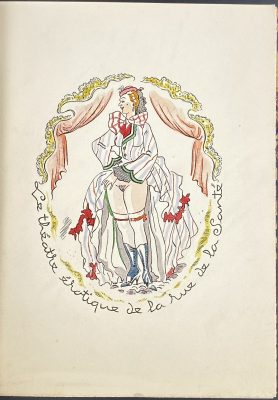

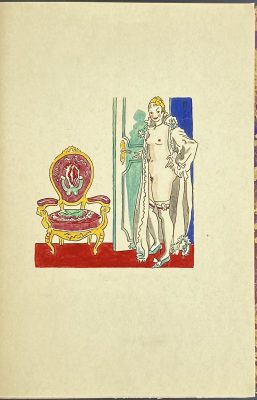
-
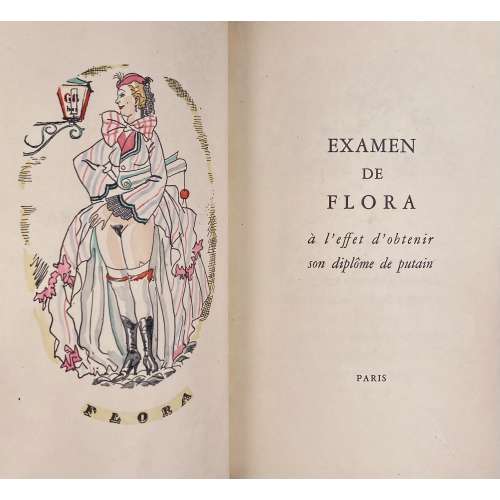 Description: Hardcover, 19 x 13 cm, contemporary binding, ¾ carrot morocco with raised bands over patterned cloth, similarly patterned endpapers, original pink wrappers preserved, gilt lettering to spine, Japanese previous owner’s stamp フィリップ (Firippu or Philippe) to verso front endpaper. Title-page: EXAMEN | DE | FLORA | à l’effet d’obtenir | son diplôme de putain | PARIS || Collation/pagination: blank flyleaf, original front wrapper with vignette, [1] blank, original watercolour 13.5 x 11 cm bound in, [2] blank, [3] h.t. / frontispiece, [4] t.p., 5-45 [46] [2] limitation / blank, back wrapper, blank flyleaf, with 14 stencil-coloured photogravures (au pochoir), two of them full-page, incl. frontispiece, after Feodor Rojankovsky [Rojan]. Limitation: 15 copies on Japon and 300 copies on Vélin, this is copy № 7. Edition: 1st edition thus, illustrated with 14 coloured photogravures, 2 of them full-page after Feodor Rojankovsky [Rojan], enriched with an original watercolour by the same artist. Catalogue raisonné: Dutel (1920-1970): 1532, p. 160 (same copy); honesterotica.com Provenance: J.-P. Dutel Note: J.-P. Dutel dates the edition as “vers 1935”; however, based on the edition of Le théâtre érotique de la rue de la Santé / [illustré par Rojan]. — Paris: s.n., 1932 [LIB-2816.2021] in this collection, which contains some of the same illustrations, we attribute it to 1932. Contributors: Feodor Rojankovsky [Rojan, Фёдор Степанович Рожанковский] (Russian-American, 1891 – 1970) – artist. Louis Protat (French, 1819 – 1881) – author. Illustrations:
Description: Hardcover, 19 x 13 cm, contemporary binding, ¾ carrot morocco with raised bands over patterned cloth, similarly patterned endpapers, original pink wrappers preserved, gilt lettering to spine, Japanese previous owner’s stamp フィリップ (Firippu or Philippe) to verso front endpaper. Title-page: EXAMEN | DE | FLORA | à l’effet d’obtenir | son diplôme de putain | PARIS || Collation/pagination: blank flyleaf, original front wrapper with vignette, [1] blank, original watercolour 13.5 x 11 cm bound in, [2] blank, [3] h.t. / frontispiece, [4] t.p., 5-45 [46] [2] limitation / blank, back wrapper, blank flyleaf, with 14 stencil-coloured photogravures (au pochoir), two of them full-page, incl. frontispiece, after Feodor Rojankovsky [Rojan]. Limitation: 15 copies on Japon and 300 copies on Vélin, this is copy № 7. Edition: 1st edition thus, illustrated with 14 coloured photogravures, 2 of them full-page after Feodor Rojankovsky [Rojan], enriched with an original watercolour by the same artist. Catalogue raisonné: Dutel (1920-1970): 1532, p. 160 (same copy); honesterotica.com Provenance: J.-P. Dutel Note: J.-P. Dutel dates the edition as “vers 1935”; however, based on the edition of Le théâtre érotique de la rue de la Santé / [illustré par Rojan]. — Paris: s.n., 1932 [LIB-2816.2021] in this collection, which contains some of the same illustrations, we attribute it to 1932. Contributors: Feodor Rojankovsky [Rojan, Фёдор Степанович Рожанковский] (Russian-American, 1891 – 1970) – artist. Louis Protat (French, 1819 – 1881) – author. Illustrations: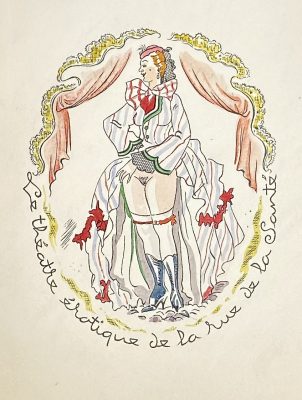
Le théâtre érotique / Original
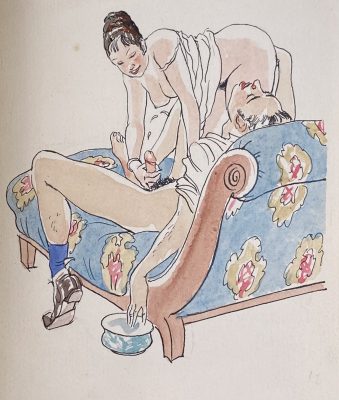
Examen de Flora / Original
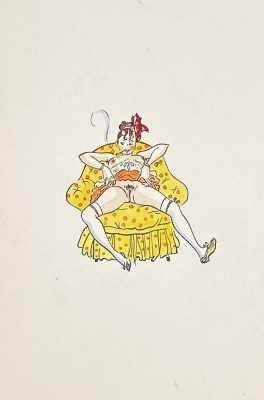
Le théâtre érotique / Original
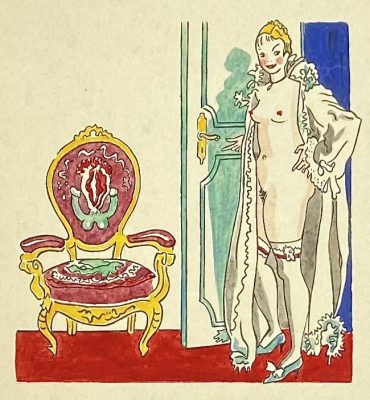
Le théâtre érotique / Original
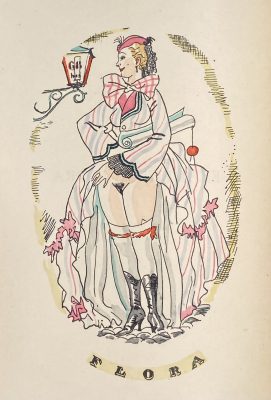
Examen de Flora / Print
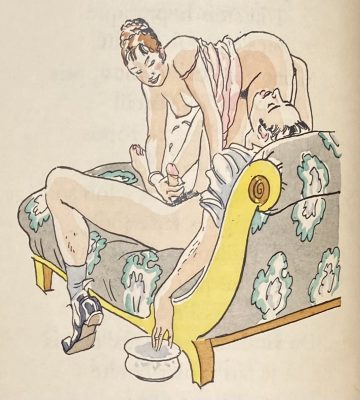
Examen de Flora / Print
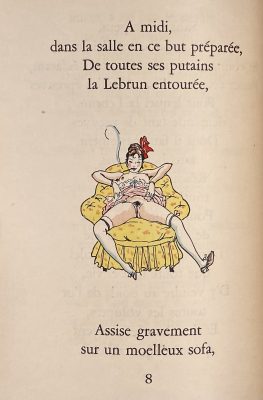
Examen de Flora / Print
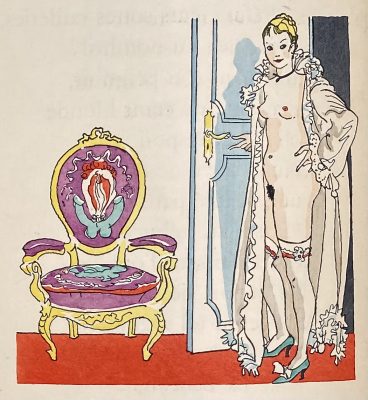
Examen de Flora / Print


